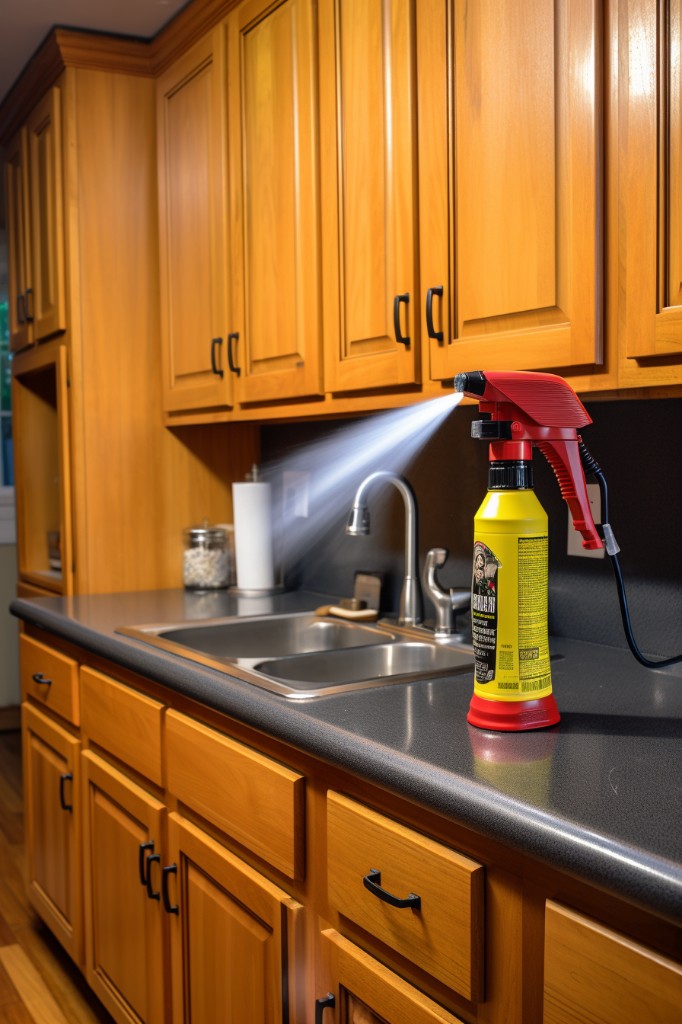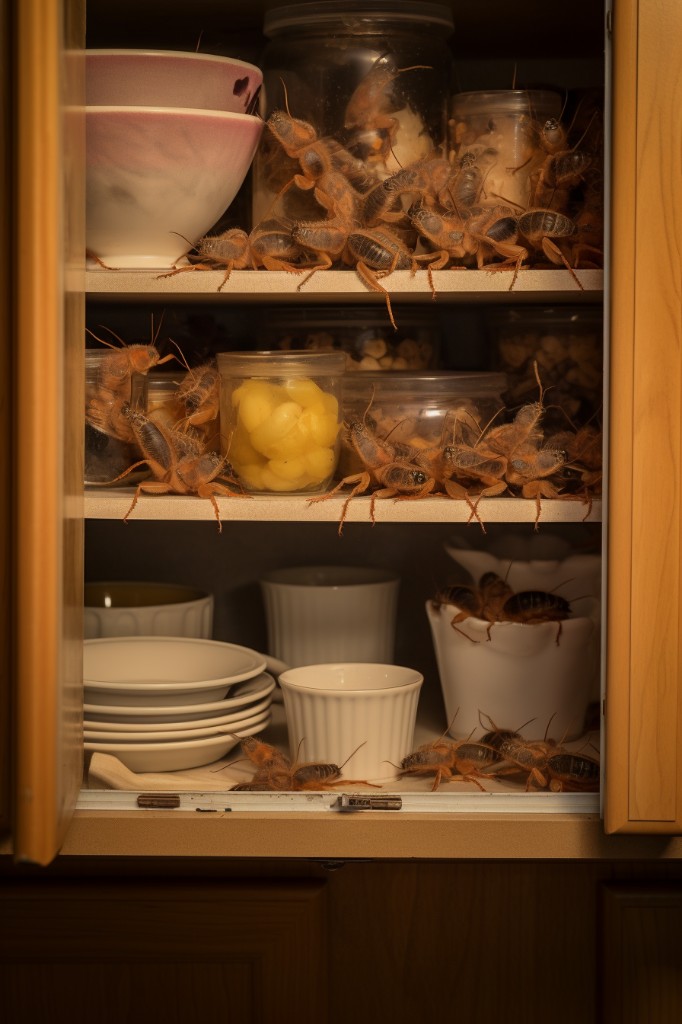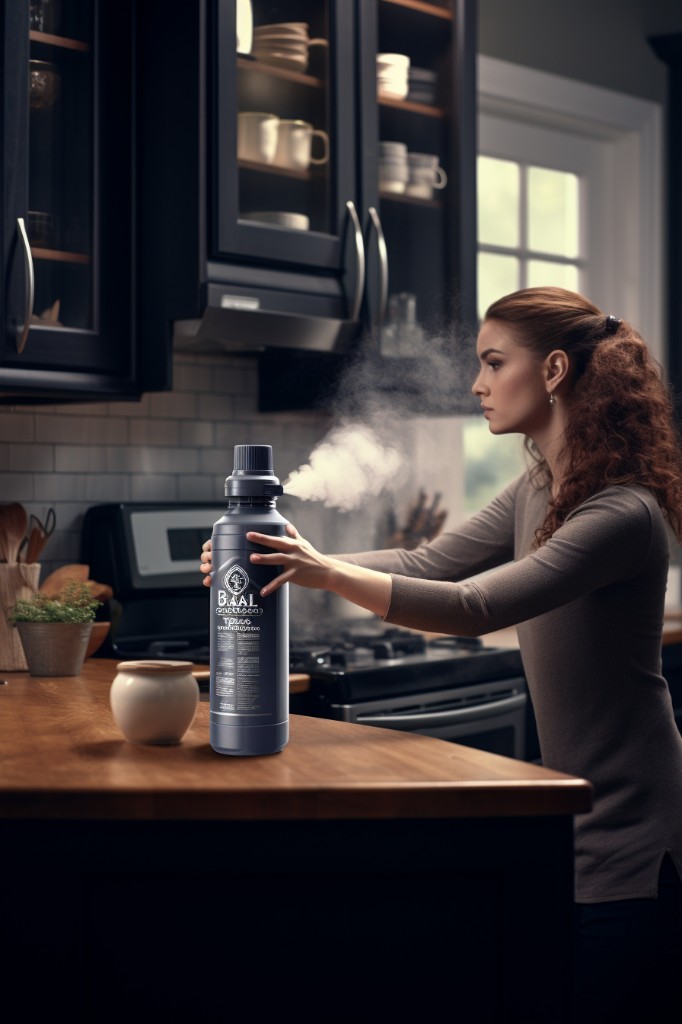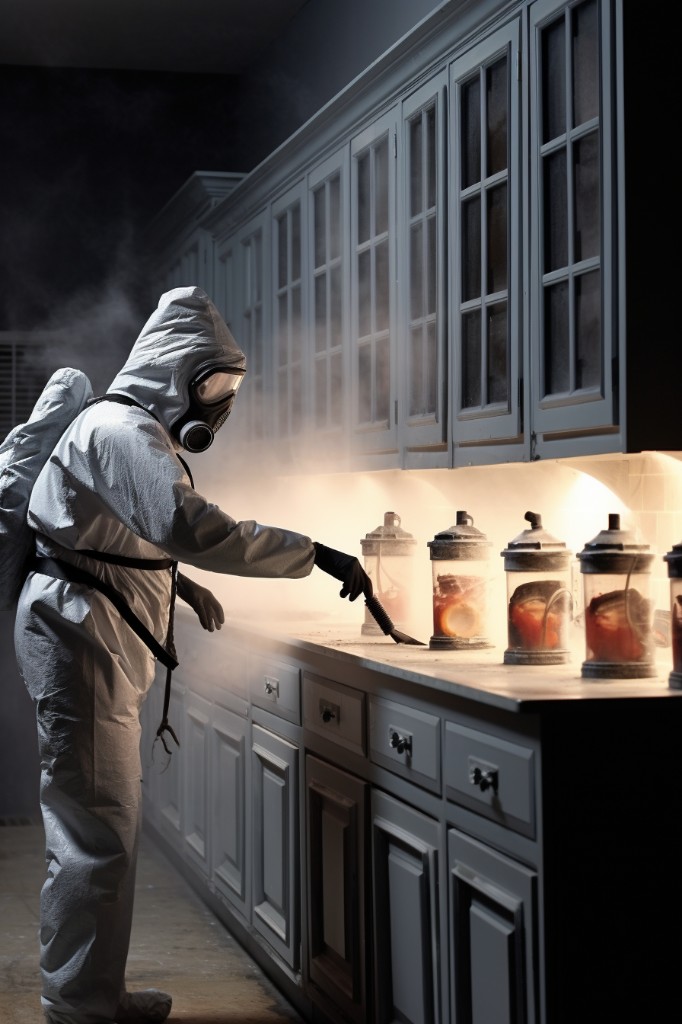Last updated on
Discover the do’s and don’ts of using Raid in your kitchen cabinets to effectively deal with unwanted pests while keeping your home safe.
Have you ever opened your kitchen cabinets only to find creepy crawlies scurrying around? It’s a nightmare for any homeowner, and the first instinct is to reach for a can of Raid. But before you start spraying, it’s important to know if it’s safe to use insecticide inside your kitchen cabinets.
In this article, we’ll explore whether or not you can spray Raid in kitchen cabinets and provide some alternative solutions for keeping pests at bay. Keep reading to ensure your home remains pest-free without putting yourself or your family at risk!
What's Inside
Understanding Raid: Ingredients and Effects

Raid is a popular insecticide that contains active ingredients such as pyrethroids and imiprothrin. These chemicals work by attacking the nervous system of insects, causing paralysis and death.
While effective against pests like ants, roaches, and spiders, these chemicals can also be harmful to humans if not used properly. Exposure to high levels of pyrethroids can cause symptoms such as dizziness, nausea or vomiting while long-term exposure may lead to more severe health problems.
It’s essential always to read the label before using any pesticide product in your home carefully. The label will provide information on how much product should be used for specific pests and where it should be applied safely.
Understanding the ingredients contained within Raid is crucial when deciding whether or not it’s safe for use inside kitchen cabinets or other areas of your home where food is stored.
Identifying Common Kitchen Pests

Knowing what kind of insect has invaded your space will help you choose the right treatment method and prevent future infestations.
Some common kitchen pests include:
- Ants: These tiny insects are attracted to sweet, sugary foods and crumbs left behind on countertops or floors.
- Cockroaches: They thrive in warm, humid environments like kitchens and can contaminate food by leaving droppings behind.
- Pantry moths: These small brownish-gray moths lay their eggs on stored grains, flour, cereal or pet food which hatch into larvae that feed on these items.
- Silverfish: They love starchy foods such as pasta and flour but also eat paper products like cardboard boxes used for storing dry goods.
Assessing Raid Safety in the Kitchen

While Raid is an effective insecticide, it contains chemicals that can be harmful if not used correctly. The active ingredients in most Raid products are pyrethrins and pyrethroids, which target the nervous system of insects and cause paralysis or death.
However, these same chemicals can also affect humans and pets if ingested or inhaled. Therefore, before spraying any insecticide inside your kitchen cabinets:
- Ensure proper ventilation by opening windows or turning on exhaust fans.
- Remove all food items from the area to prevent contamination.
- Cover dishes and utensils with a cloth or plastic wrap.
- Wear protective gear such as gloves and a mask while applying the spray.
It’s important to note that some people may be more sensitive than others when exposed to pesticides like Raid. Children under six years old are particularly vulnerable due to their developing immune systems.
If you have pets at home who might come into contact with sprayed surfaces (such as cats who jump onto countertops), consider using alternative pest control methods instead of relying solely on chemical sprays like Raid.
Is Raid Safe to Use in Kitchen Cabinets

When it comes to using Raid in kitchen cabinets, safety concerns arise due to the proximity of food and dishes. The good news is that Raid can be used safely in kitchen cabinets as long as you take proper precautions.
Before spraying any insecticide inside your kitchen cabinets, make sure they are empty and all food items are removed or sealed tightly. Also, ensure there’s no open flame or heat source nearby before you start spraying.
When applying Raid inside your kitchen cabinet, wear gloves and a mask for protection against inhalation or skin contact with the chemicals. Spray lightly on surfaces where pests have been spotted but avoid over-spraying which could lead to contamination of utensils and other items stored within the cabinet.
After application leave the doors open for ventilation until dry then wipe down all surfaces with warm soapy water before returning any item back into them.
Precautions Before Spraying Raid
First, make sure that all food items and utensils are removed from the cabinets before application. This will prevent any contamination of food or surfaces with insecticide residue.
Next, wear protective gear such as gloves and a mask while applying the spray. This will protect your skin from coming into contact with the chemicals in Raid and prevent inhalation of fumes.
It’s also essential to read the label instructions carefully before use. Follow them strictly for optimal results without putting yourself at risk.
Lastly, keep children away from treated areas until they have been thoroughly cleaned after application.
How to Use Raid Safely in Kitchen Cabinets
Here are some tips on how to use Raid safely and effectively:
1. Read the label: Before using any insecticide, make sure you read the label carefully and follow all instructions.
2. Wear protective gear: It’s important to wear gloves, long sleeves, pants and shoes when handling insecticides like Raid.
3. Ventilate the area: Open windows or turn on fans before spraying raid inside your kitchen cabinets for proper ventilation.
4. Remove food items from cabinets: Take out all food items from your kitchen cabinet before applying raid spray as it can contaminate them with chemicals that may cause harm if ingested later.
5. Spray lightly and evenly: Apply a light mist of spray evenly throughout each cabinet without over-saturating surfaces or leaving puddles behind.
6. Wait for recommended time period: Allow enough time (usually 15-20 minutes) for the product to work its magic before wiping down surfaces with a damp cloth.
Spray Techniques for Kitchen Cabinets
First and foremost, make sure you have read the instructions on the can carefully before use. Shake well and hold the can at least 18 inches away from your cabinets while spraying.
It’s important to spray only where necessary – avoid over-spraying or saturating surfaces as this could lead to damage or contamination of food items stored inside. Pay close attention to cracks and crevices where pests may be hiding.
After application, leave cabinet doors open for a few hours until any residual fumes dissipate completely. Proper ventilation is key in ensuring safety after using insecticides indoors.
Remember that Raid should always be used with caution around food preparation areas – if possible, remove all dishes and utensils from affected cabinets before applying insecticide.
Ventilation and Post-Spray Safety
One crucial step is ensuring proper ventilation during and after application. Open all windows and doors to allow fresh air into the room while you spray, as well as for several hours afterward.
It’s also essential to keep children and pets away from the treated area until it has completely dried. If possible, remove any food or dishes from your cabinets before spraying Raid inside them.
Once you’ve finished applying Raid in your kitchen cabinets, be sure to clean up any excess product that may have spilled or dripped onto surfaces outside of the cabinet itself. Use a damp cloth with soap and water for cleaning purposes.
Remember that even though Raid can effectively eliminate pests in your home, it should always be used with caution due to its potentially harmful effects on humans if not handled properly.
Risks of Inhalation and Ingestion
One of the most significant dangers is inhalation and ingestion. When sprayed, Raid releases a mist that contains chemicals such as pyrethroids and piperonyl butoxide which can cause respiratory problems if inhaled excessively or ingested accidentally.
Inhaling these chemicals may lead to coughing, wheezing, shortness of breath or even asthma attacks especially for people who are sensitive to chemical odors. Ingestion could result from accidental contact by children or pets who might lick surfaces treated with Raid.
To minimize these risks when using Raid inside your kitchen cabinets:
- Always wear gloves and a mask while spraying.
- Keep children and pets away from the area until after ventilation has been completed.
- Ensure proper ventilation by opening windows before spraying.
- Avoid storing food items directly on shelves where you have applied insecticide spray
- If you experience any adverse reactions after using raid like dizziness nausea headache seek medical attention immediately.
What Should You Do If You Have Pets And Kids Sensitive To Raid
The chemicals in insecticides can be harmful if ingested or inhaled, and young children and animals are particularly vulnerable. If you’re concerned about the safety of using Raid around your family members, consider alternative pest control solutions that are less toxic.
However, if you must use Raid to deal with a severe infestation problem inside your kitchen cabinets despite having pets and kids sensitive to it; make sure they stay away from the area while spraying is ongoing. Afterward, keep them out of the treated space for several hours until all traces of chemical odor dissipate completely.
It’s also crucial that any food items stored inside these cabinets should be removed before applying insecticide spray as they may become contaminated by residual chemicals left behind after treatment.
Proper Cleaning After Raid Application
This will help remove any remaining chemicals and prevent contamination of your food or dishes. Start by removing all items from the cabinets and wiping them down with warm soapy water.
Be sure to rinse everything well before returning it to its place.
Next, use a damp cloth or sponge to wipe down the inside of each cabinet thoroughly. Pay special attention to corners and crevices where insects may have been hiding.
Once you’ve wiped everything down, allow the cabinets ample time for ventilation before putting anything back inside them. Open windows if possible or turn on fans for better air circulation.
It’s also important not to mix cleaning products with Raid as this can create dangerous chemical reactions that could harm you or damage surfaces in your home.
Alternatives to Raid for Kitchen Pests
One of the most effective ways is to maintain a clean and tidy kitchen by wiping down surfaces regularly, storing food in sealed containers, and taking out the trash daily. This will eliminate potential food sources for pests.
Another natural solution is using essential oils such as peppermint or eucalyptus oil which have been known to repel insects. Simply mix a few drops with water and spray it around your cabinets.
You can also try making homemade traps using simple ingredients like sugar water or vinegar mixed with dish soap placed in small jars near areas where you’ve seen pest activity.
Lastly, consider calling a professional exterminator who can provide safe and effective pest control services tailored specifically for your home’s needs without putting yourself or family members at risk.
Natural and DIY Pest Control Solutions
One of the most effective ways to prevent pests is by keeping your kitchen clean and free of food debris. Wipe down counters, sweep floors regularly, and store food in airtight containers.
Another natural solution is to use essential oils like peppermint or eucalyptus as a deterrent for ants or other insects. Simply mix a few drops with water in a spray bottle and apply it around the perimeter of your cabinets.
For those who prefer DIY solutions, boric acid mixed with sugar can be an effective bait for roaches when placed strategically inside cabinets where they tend to hide.
While these methods may take longer than insecticides like Raid to show results, they are safer alternatives that won’t harm you or your family’s health.
Ensuring Long-term Pest Prevention
Here are some tips for ensuring long-term pest prevention:
1. Keep your kitchen clean: Regularly wipe down surfaces and sweep up crumbs and spills that can attract pests.
2. Store food properly: Use airtight containers for dry goods like cereal, flour, and sugar.
Don’t leave open packages of food lying around.
3. Seal cracks and gaps: Pests can enter through even the tiniest openings in walls or cabinets, so seal any gaps or holes you find.
4. Fix leaks promptly: Moisture attracts pests like cockroaches and silverfish, so fix any leaky pipes or faucets as soon as possible.
5. Maintain outdoor areas: Trim back trees or bushes that touch your home’s exterior walls since they provide an easy pathway for pests into your home.
When to Call a Professional Exterminator
A pest control expert can help identify the root cause of your infestation and provide targeted treatments that are safe for your home and family. They’ll also have access to more potent insecticides that aren’t available over-the-counter.
It’s important to note that while hiring an exterminator may seem like an expensive option, it could save you money in the long run by preventing further damage caused by pests. Some infestations require specialized equipment or techniques which only professionals possess.
When deciding whether or not to hire a professional exterminator, consider factors such as:
- The severity of the infestation
- The type of pest(s) present
- Your personal comfort level with handling pesticides
- Any allergies or sensitivities within your household
FAQ
Can you spray insecticide in kitchen cabinets?
Yes, you can spray insecticide in kitchen cabinets for treating cockroaches, but it is preferable to keep chemicals out of cupboards.
How do I get rid of bugs in my kitchen cabinets?
To get rid of bugs in your kitchen cabinets, empty the pantry, vacuum shelves, floors, and corners, then wash the surfaces with soapy water without using bleach, ammonia, or pesticides.
How do you spray raid in a kitchen?
To spray Raid in a kitchen, remove or cover exposed food and utensils, cover countertops and other food-related surfaces, avoid spraying into the air, and test on an inconspicuous area before applying.
What precautions should be taken when using bug spray around food storage areas?
When using bug spray around food storage areas, ensure to cover or remove food items and utensils, and thoroughly clean surfaces after spraying to avoid contamination.
Are there any natural alternatives to using Raid for eliminating pests in kitchen cabinets?
Yes, natural alternatives to Raid for eliminating pests in kitchen cabinets include using essential oils, vinegar, and diatomaceous earth.
How can you safely apply insecticides to kitchen cabinets without causing harm to humans or pets?
To safely apply insecticides to kitchen cabinets without causing harm to humans or pets, one should use a pet and human-safe product, follow label instructions, and keep the area well-ventilated while avoiding contact with food and dishes.




